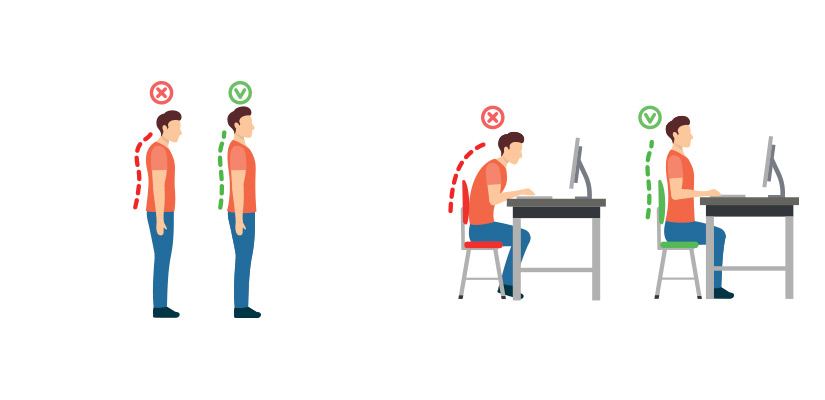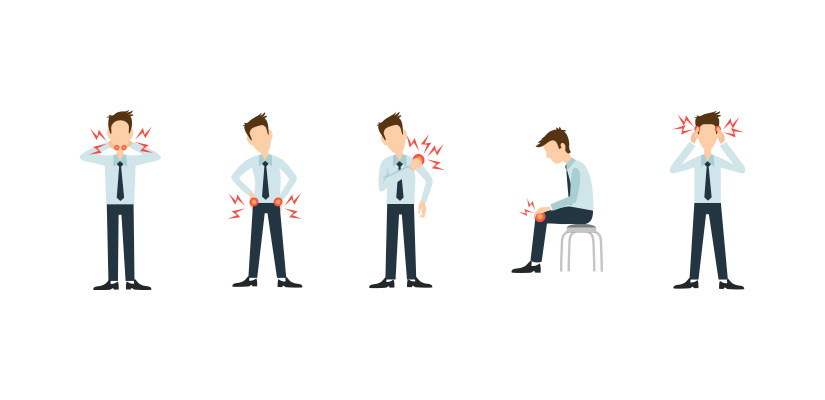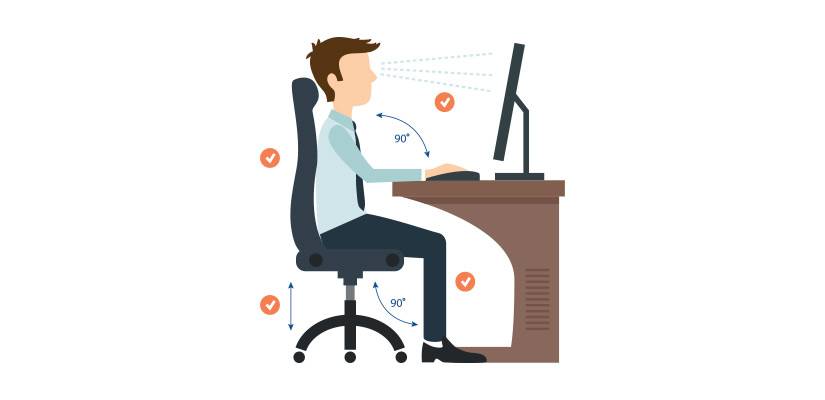The Professional’s Guide to Perfect Posture: Easy Fixes

Did you know your posture is the foundation of your overall physical health and well-being? It is much more than simply standing or sitting up straight. Simply put, posture refers to how you hold your body when moving and at rest. There are two distinct types: dynamic posture (how you hold yourself while walking, running, or bending) and static posture (how you position yourself when sitting, standing, or sleeping).
Good posture maintains the three natural curves of your spine—at your neck, mid-back, and lower back—creating what professionals call a neutral “S-shaped” spine. When properly aligned, your head sits directly above your shoulders, your shoulders align with your hips, and your weight distributes evenly across your body.

Maintaining proper posture isn’t just about appearances—it significantly impacts your health. Good posture does so much more. It:
- reduces strain on muscles and joints,
- prevents abnormal wear on your spine,
- improves breathing capacity,
- enhances digestion, and
- boosts your mood and energy levels.
Proper posture is especially crucial for McAllen professionals who spend long hours at their desks. Prolonged sitting with poor alignment can lead to chronic pain, decreased productivity, and potential long-term health complications.
Consequences of Poor Posture in Professional Settings

The result of not paying attention to poor posture:
- Physical effects: Neck and back pain, weakened core muscles, joint degeneration, and reduced flexibility
- Physiological effects: Shallow breathing, poor digestion, and reduced oxygen circulation
- Psychological effects: Fatigue, mood swings, and decreased confidence
- Professional impact: Lower productivity, more sick days, and potential risk of disability
- Long-term risks: Permanent spinal changes, chronic pain, and a higher risk of falls in later years
Work-related posture problems cost employers billions of dollars annually in lost productivity, healthcare expenses, and missed workdays. Fortunately, many of these posture-related issues can be prevented or corrected with proper awareness and interventions.
How to Fix Your Posture Correction?

Ergonomics: Setting Up a Posture-Friendly Workspace
Ergonomics—the science of designing work environments to fit the human body—is crucial in maintaining good posture. When configured correctly, your workspace naturally encourages correct alignment and reduces strain on your body.
Chair:
- Feet must rest comfortably flat on the floor.
- Knees at a 90° angle.
- The lower back must be supported, either by the chair’s design or with a small cushion.
Desk:
- The height should position your elbows at approximately 90° when typing.
- Standing desks have gained popularity as an alternative to traditional setups. To optimize posture benefits, use a standing desk and follow the 20:8:2 rule—20 minutes sitting, 8 minutes standing, and 2 minutes moving. Position your standing desk so your elbows form a 90-degree angle when typing, and ensure your monitor remains at eye level.
Workstation Elements for Posture Correction
| Workstation Element | Optimal Position |
| Monitor | At eye level, arm’s length away |
| Chair | Feet flat, knees at 90°, back supported |
| Keyboard | Elbows at 90°, wrists straight |
| Frequently used items | Within arm’s reach to avoid stretching |
Take regular breaks
Remember that even the most ergonomic setup requires movement breaks. Set a timer to remind yourself to stand, stretch, or walk briefly every 30 to 45 minutes to prevent muscle fatigue and maintain good posture throughout your workday.
Exercises to Improve Posture
The good news is that it is never too late to improve your posture, regardless of age or how long you’ve had poor alignment habits. You do even necessarily need a back brace for posture. Correct posture requires consistent, mindful adjustments and strengthening of the correct muscle groups. You can gradually retrain your body to maintain proper alignment by incorporating specific exercises into your routine.
Simple Office-Friendly Exercises

Integrating posture-improving exercises into your workday can be fun and done in your break. Try these simple techniques that can be performed right at your desk:
Shoulder Rolls: Inhale as you raise your shoulders to your ears, then exhale as you pull your shoulder blades down and together. Repeat 5-10 times throughout the day.
Seated Chest Stretch: Clasp your hands behind your back, locking your fingers with palms facing you. Lift your hands upward to the point of gentle tension, hold for 10 seconds, and release. Repeat 2-4 times.
Chin Tucks: Pull your chin straight back toward your neck ten times. You should feel the muscles in the back of your neck working.
Scapula Squeezes: Squeeze your shoulder blades together for 30 seconds to strengthen upper back muscles.
Daily Habits for Better Posture
Implementing these simple habits can make a significant difference in your posture over time:
Posture Check Triggers:
- Use everyday activities as reminders to check your posture. For example, every time you check your phone, email, or watch, take a moment to assess and correct your alignment.
- The 20-8-2 Rule: Aim for 20 minutes of sitting, 8 minutes of standing, and 2 minutes of movement each 30 to 45 minutes. Set timers if needed to remind yourself to change positions.
- Invisible String Visualization: Imagine an invisible string extending from your tailbone up your spine and out the top of your head, drawing you upward. This mental image helps maintain proper alignment naturally.
- Posture Self-Assessment: Regularly practice this quick assessment: slouch deliberately, then overcorrect to a military-straight posture, and finally settle into a comfortable middle ground where your ears align with your shoulders.
Yoga and Pilates for Posture Improvement
Join a group or start a Yoga and Pilates group at work. These exercises efficiently develop the core strength and body awareness necessary for good posture. These practices emphasize proper alignment while strengthening the muscles that support your spine. Several specific poses can be especially beneficial, such as cat-cow pose, planks, child’s pose, and more.
Remember that consistency is key. These exercises and habits are most effective when performed regularly as part of your daily routine. Start with a few minutes each day and gradually increase as these posture-improving practices become second nature.
The Role of XO Physical Therapy
While self-correction strategies are valuable, persistent posture issues often benefit from professional intervention. Physical therapy is a movement-based science designed to treat existing problems and prevent future injuries.
For professionals in McAllen struggling with posture-related pain, physical therapists offer expertise in identifying the root biomechanical causes of discomfort and developing targeted solutions. Their approach begins with a comprehensive hands-on assessment to identify specific posture issues, followed by personalized treatment plans that retrain proper body mechanics. Don’t let lousy posture hold you back any longer. Contact us today to schedule your consultation and start your journey towards a pain-free, upright life!




